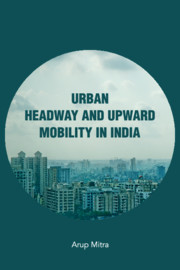Book contents
- Frontmatter
- Contents
- List of Tables
- Acknowledgements
- 1 Analytical Frame
- 2 Assessing the Quality of Cities and Towns
- 3 New Patterns and New Strategies in Indian Urbanization
- 4 Growth, Informal Sector Employment and Poverty
- 5 Upward Mobility of the Disadvantaged Sections
- 6 Erosion of the Caste Factor?
- 7 Changes in a Cultural Variable
- Bibliography
- Index
5 - Upward Mobility of the Disadvantaged Sections
Published online by Cambridge University Press: 30 April 2020
- Frontmatter
- Contents
- List of Tables
- Acknowledgements
- 1 Analytical Frame
- 2 Assessing the Quality of Cities and Towns
- 3 New Patterns and New Strategies in Indian Urbanization
- 4 Growth, Informal Sector Employment and Poverty
- 5 Upward Mobility of the Disadvantaged Sections
- 6 Erosion of the Caste Factor?
- 7 Changes in a Cultural Variable
- Bibliography
- Index
Summary
Perspective
In what way human behaviour intermingles with changing economic activities and results in better sources of livelihood for making the urbanization process inclusive is a pertinent issue. The disadvantaged section can be conceptualized in a number of ways. The most convenient way of capturing it is to focus on those who suffer from housing poverty. In what way the slum households located at the lowest rungs of urban space do or do not benefit in the process of urbanization can then be analysed with profundity.
Focussing on the survival strategies of the slums we note that migrants, particularly from the rural areas, access information on the urban labour market through various informal channels, and hope to experience upward income mobility by migrating to the urban areas. However, one missing area of research relates to the segmented nature of the urban labour market due to specialization of activities in different areas (zones) within a city. Segmentation along the lines of caste, skill, and education has of course drawn adequate attention of the scholars, but the physical segmentation of the labour market is an issue that has received relatively less attention. By physical segmentation we mean inaccessibility of certain kinds of jobs by certain group of individuals, primarily because of the distance factor within a city: high-income jobs may be available in a particular locality, but their physical distance from the place where one specific group of migrants resides in the city could be so enormous that such jobs may remain inaccessible to them. Even inexpensive (intra-city) transport for commutation need not eliminate these labour market barriers, especially in developing countries. Hence, occupational choice is greatly determined by the narrow spectrum of jobs available within the geographic area where the migrants reside, rather than by what they are capable of pursuing. Contact-based migration tends to provide jobs in neighbourhoods close to their residence: the early settlers help their relatives, friends, members of the same caste groups and co-villagers to migrate to the city by providing information on job and space to settle down, which is often in the same gamut of space and activities that they themselves have access to.
- Type
- Chapter
- Information
- Urban Headway and Upward Mobility in India , pp. 91 - 118Publisher: Cambridge University PressPrint publication year: 2020



